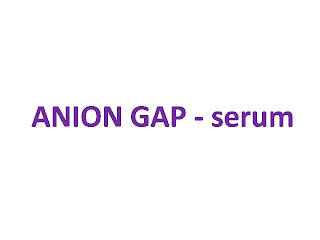ANION GAP - serum
Application: Investigation of metabolic acidosis.
Explanation: Since serum is electrically neutral, total anions and total cations must be equal. Na+ and K+ are the major reported cations. Cl- and HCO3- are the major reported anions. The totals of anion and cations in serum are not equal. The sum of unreported cations, such as, Ca++ and Mg++ average 7 mEq/L, and the sum of unmeasured anions (proteins, phosphate, sulfates, organic acids), average 24 mEq/L. So, normally, there exists a net excess of about 17 mEq/L of unmeasured anions in serum. When the total Cl- and total CO2 concentrations are added together and subtracted from the Na+ and K+ concentrations, the difference should be less than or equal to 17 mEq/L. If the anion gap exceeds 17 mEq/L, it indicates an increase in one or more of the unmeasured anions.
Anion gap = (Na + K) - (Cl + HCO3).
Causes for increased anion gap are: metabolic acidosis (e.g.- lactic acidosis), uremia, ketotic states, toxin ingestion, such as methanol or salicylates. Metabolic acidosis with a normal anion gap is seen in renal tubular acidosis and in other causes of bicarbonate loss (e.g.- diarrhea).
Specimen: 5 ml blood in red-top tube.
Reference Interval:
8-16 mEq/L
Top Medical Journal
Friday, March 1, 2013
Subscribe to:
Post Comments (Atom)

0 comments:
Post a Comment